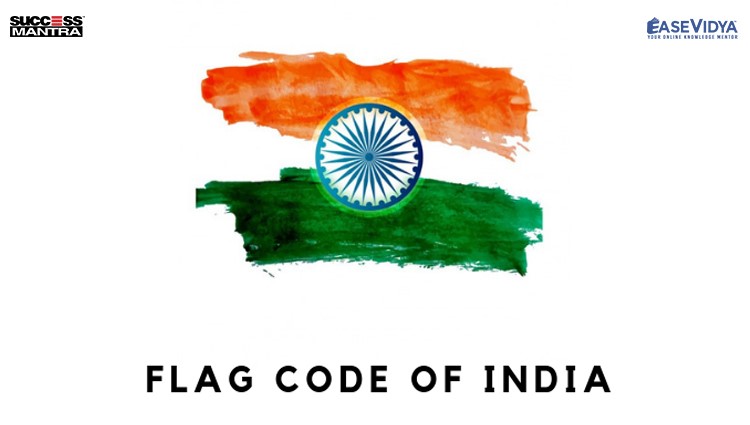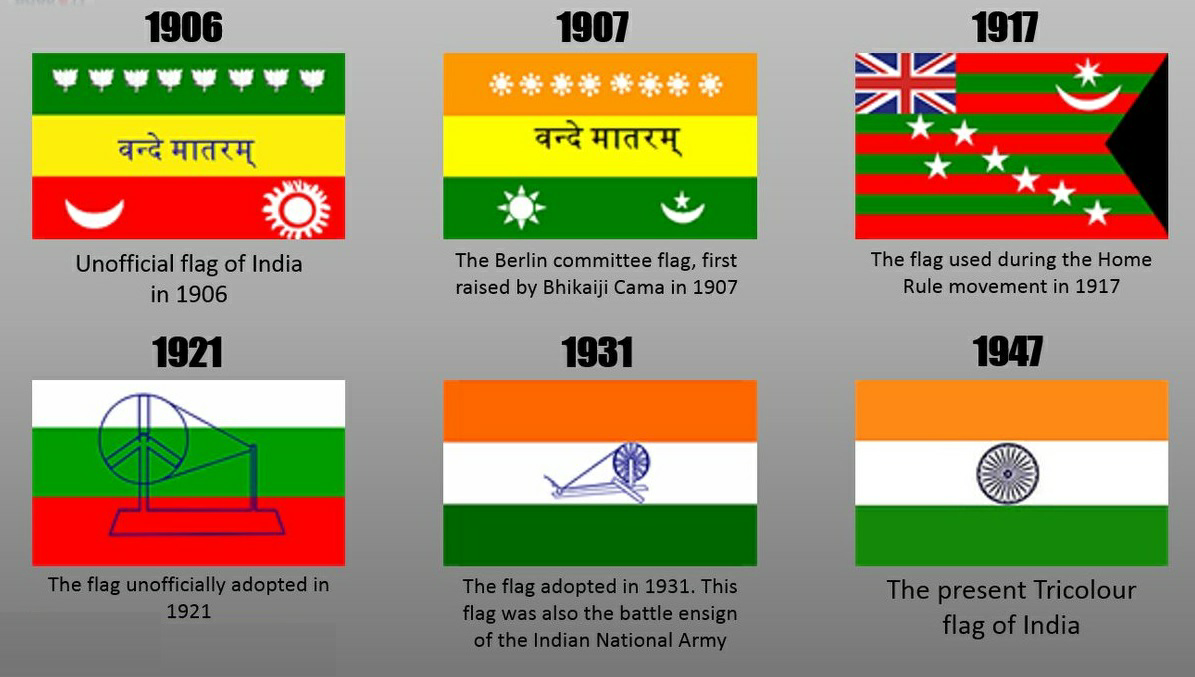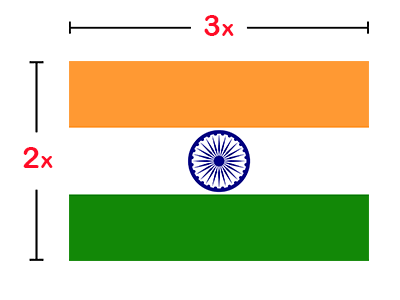
Flag code of India
Flag code of India
Context:
Khadi Sanghas activists have written to the prime minister on the move to allow non-khadi material for the national flag.
The amendments:
As per rule 1. 2 of part 1 of the flag code of 2002, only khadi or hand-spun cloth was the material for the flag. Use of other material was punishable.
- But the recent amendment has changed it to “The National Flag shall be made of hand spun and hand woven or machine made, cotton, polyester, wool, silk khadi bunting.”
- That means machine made polyester that is made in India or imported from elsewhere can now be used for the tricolour.
So far, the hand spun, hand woven khadi flag was made in the country’s sole BIS-approved flag manufacturing unit in Hubballi, Karnataka.
- They now contend that the move will only dilute the definition of khadi but also undermine the spirit of freedom struggle.
Previous amendments to the Flag Code:
- The code has been amended earlier too. The original flag code of India 1947 was amended in 2002 after a Supreme Court judgement.
- This expanded the definition of places where the flag could be displayed or hoisted. However, part one of the code that deals with the description of the flag had remained untouched.
Evolution of National flag:

- Present flag is based on the Swaraj flag, a flag of the Indian National Congress designed by pingali vekayya.
- After undergoing several changes, the Tricolour was adopted as our national flag at a Congress Committee meeting in Karachi in 1931.
Constitutional & Statutory Provisions regarding National Flag of India:
Art 51A(a) – To abide by the Constitution and respect its ideals and institutions, the National Flag and the National Anthem.
Statutes Governing Use of Flag:
- Emblems and Names (Prevention of Improper Use) Act, 1950.
- Prevention of Insults to National Honour Act, 1971.
Rules governing the display of the Tricolour:
The flag code 2002 is divided into three parts:
1-a general description of the tricolour
2-rules for display of the flag by governments and government bodies.
3-rules on display of the flag by public and private bodies and educational institutions.
Notable facts:
- The National Flag of India shall be made of hand spun and hand woven wool/cotton/silk khadi bunting.
- The National Flag shall be rectangular in shape. The ratio of the length to the height (width) of the Flag shall be 3:2.
- The Flag shall not be flown at half-mast except on occasions on which the Flag is flown at half-mast on public buildings in accordance with the instructions issued by the Government.
- The Flag shall not be used as a drapery in any form whatsoever, including private funerals except in State funerals or armed forces or other paramilitary forces funerals”.
- The Flag shall not be used as a portion of costume or uniform of any description nor shall it be embroidered or printed upon cushions, handkerchiefs, napkins or any dress material.

Sarvepalli Radhakrishnan narrated significance of National flag as:
- The “Ashoka Chakra” is the wheel of the law of dharma. Chakra intend to show that there is LIFE IN MOVEMENT and death in stagnation.
- The saffron colour denotes renunciation of disinterestedness.
- The white in the centre is light, the path of truth to guide our conduct.
- The green shows our relation to the soil, our relation to the plant life here, on which all other life depends.













tfxoywnotm
Flag code of India | Read Daily Article Editorials Only On Success Mantra Blog | Daily Article | Monthly Article | Weekly Article | Yearly Article | Most Requesting Articles | Legal Awareness Articles | Current Affairs | Passage Based Current Affairs | One Linear Current Affairs | Current Affairs For CLAT | Current Affairs For AILET | Current Affairs For Slat | Legal Aptitude Current Affairs | Law Current Affairs | Current Event | Current Affairs Pdf | Current Affairs Pdf In English | Current Affairs Pdf Free Download | Current Affairs MCQ | Current Affairs MCQS | Current Affairs Work Sheet | Current Affairs UPSC | Current Affairs BBA | Current Affairs BCA | Current Affairs BJMC | Current Affairs NCHMJEE | Daily Editorial | Monthly Editorial | Weekly Editorial | Yearly Editorial | Most Asking Editorials | Legal Awareness Editorials | Current Editorial | Passage Based Current Editorial | One Linear Current Editorial | Current Editorial For CLAT | Current Editorial For AILET | Current Editorial For Slat | Legal Aptitude Current Editorial | Law Current Editorial | Current Event | Current Editorial Pdf | Current Editorial Pdf In ENGLISH | Current Editorial Pdf Free Download | Current Editorial MCQ | Current Editorial MCQS | Current Editorial Work Sheet | Current Editorial UPSC | Current Editorial BBA | Current Editorial BCA | Current Editorial BJMC | Current Editorial NCHMJEE | Latest News In India | Latest News In Hindi | Latest News Delhi | Latest News Today India | Latest News Live | 3 Latest News | Latest News Today Delhi | Latest News Aajtak | News Articles India | News Articles For Students | News Articles 2022 | News Articles In English | News Articles In Hindi | News Article Example | Short News Articles | News Article Meaning | Success Mantra Delhi | CLAT Coaching In Delhi | Best CLAT Du LLB Institute In Delhi | Read Daily Article Editorials Only On Success Mantra Blog [url=http://www.g9prz2843dza85768jefzv31g04z4e7ss.org/]utfxoywnotm[/url] tfxoywnotm http://www.g9prz2843dza85768jefzv31g04z4e7ss.org/ <a href="http://www.g9prz2843dza85768jefzv31g04z4e7ss.org/">atfxoywnotm</a>
igkgspeoqh
Flag code of India | Read Daily Article Editorials Only On Success Mantra Blog | Daily Article | Monthly Article | Weekly Article | Yearly Article | Most Requesting Articles | Legal Awareness Articles | Current Affairs | Passage Based Current Affairs | One Linear Current Affairs | Current Affairs For CLAT | Current Affairs For AILET | Current Affairs For Slat | Legal Aptitude Current Affairs | Law Current Affairs | Current Event | Current Affairs Pdf | Current Affairs Pdf In English | Current Affairs Pdf Free Download | Current Affairs MCQ | Current Affairs MCQS | Current Affairs Work Sheet | Current Affairs UPSC | Current Affairs BBA | Current Affairs BCA | Current Affairs BJMC | Current Affairs NCHMJEE | Daily Editorial | Monthly Editorial | Weekly Editorial | Yearly Editorial | Most Asking Editorials | Legal Awareness Editorials | Current Editorial | Passage Based Current Editorial | One Linear Current Editorial | Current Editorial For CLAT | Current Editorial For AILET | Current Editorial For Slat | Legal Aptitude Current Editorial | Law Current Editorial | Current Event | Current Editorial Pdf | Current Editorial Pdf In ENGLISH | Current Editorial Pdf Free Download | Current Editorial MCQ | Current Editorial MCQS | Current Editorial Work Sheet | Current Editorial UPSC | Current Editorial BBA | Current Editorial BCA | Current Editorial BJMC | Current Editorial NCHMJEE | Latest News In India | Latest News In Hindi | Latest News Delhi | Latest News Today India | Latest News Live | 3 Latest News | Latest News Today Delhi | Latest News Aajtak | News Articles India | News Articles For Students | News Articles 2022 | News Articles In English | News Articles In Hindi | News Article Example | Short News Articles | News Article Meaning | Success Mantra Delhi | CLAT Coaching In Delhi | Best CLAT Du LLB Institute In Delhi | Read Daily Article Editorials Only On Success Mantra Blog <a href="http://www.g5juorf665din17br19kd9t208158h6es.org/">aigkgspeoqh</a> [url=http://www.g5juorf665din17br19kd9t208158h6es.org/]uigkgspeoqh[/url] igkgspeoqh http://www.g5juorf665din17br19kd9t208158h6es.org/
myoqqwkpx
Latest News on Education & LAW Exams Blogs | Success Mantra <a href="http://www.g63gbo0fq6ux1lcb3z7667a6w951nq80s.org/">amyoqqwkpx</a> myoqqwkpx http://www.g63gbo0fq6ux1lcb3z7667a6w951nq80s.org/ [url=http://www.g63gbo0fq6ux1lcb3z7667a6w951nq80s.org/]umyoqqwkpx[/url]
Howard
5 Killer Quora Answers On Tattooed Pornstars Tattooed pornstars
iyqmeqmsx
Latest News on Education & LAW Exams Blogs | Success Mantra [url=http://www.g742209ewbe8w0x03xr021un3k3bvht5s.org/]uiyqmeqmsx[/url] <a href="http://www.g742209ewbe8w0x03xr021un3k3bvht5s.org/">aiyqmeqmsx</a> iyqmeqmsx http://www.g742209ewbe8w0x03xr021un3k3bvht5s.org/
ytvcfmbkvh
Latest News on Education & LAW Exams Blogs | Success Mantra <a href="http://www.gtc34l5b5llc871iw38a4y9m41o2y3z7s.org/">aytvcfmbkvh</a> [url=http://www.gtc34l5b5llc871iw38a4y9m41o2y3z7s.org/]uytvcfmbkvh[/url] ytvcfmbkvh http://www.gtc34l5b5llc871iw38a4y9m41o2y3z7s.org/
rssbiph
Latest News on Education & LAW Exams Blogs | Success Mantra <a href="http://www.g7o25x2n31ps37o3qvx1702jb3dhf00qs.org/">arssbiph</a> rssbiph http://www.g7o25x2n31ps37o3qvx1702jb3dhf00qs.org/ [url=http://www.g7o25x2n31ps37o3qvx1702jb3dhf00qs.org/]urssbiph[/url]